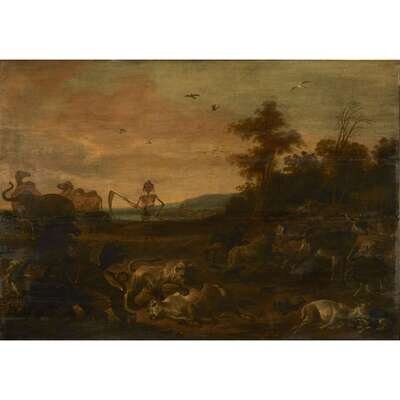Condition Report
Contact Information
Lot 1
Lot Description
Provenance: The Hawkins Collection, New Orleans.
The Berghoffer Collection, Chicago.
Collection of Judge John Barton Payne.
A gift from the above, 1919.
Property from the Virginia Museum of Fine Arts, Sold to Benefit Future Acquisitions.
LITERATURE:
Wolfgang Schulz, Cornelis Saftleven 1607-1681: Leben und Werke, Mit Einem Kritischen Katalog der Gemälde und Zeichnungen,De Gruyter, Berlin and New York, 1978, no. 518, pp. 8, 28, and 188 (illustrated).
Peter C. Sutton, A Guide to Dutch Art in America, The Netherlands-American Amity Trust, Washington D.C; Eedmans, Grand Rapids, 1986.
NOTE:
Cornelis Saftleven was born into an important family of Dutch artists in Gorinchem in 1607. After training in Rotterdam, possibly with his father Herman Saftleven (d. circa 1627), Cornelis traveled to Antwerp around 1632, where he became familiar with the work of genre scene painters Adriaen Brouwer (c.1605-1638) and David Teniers the Younger (1610-1690). While in Antwerp, Saftleven gained considerable fame and collaborated with Sir Peter Paul Rubens (1577-1640) on no less than four projects. By 1634, Cornelis was in Utrecht where he painted a portrait of the Godard van Reede family, together with his brother Herman the Younger (1609-1685). He returned to Rotterdam by 1637, where he was appointed dean of the prestigious Saint Luke's Guild in October 1667.
Saftleven was among artists of the Dutch Golden Age who never specialized in one particular genre, and thus his œuvre includes genre scenes, portraits, allegories and mythological themes, landscapes, and still lifes. Today, his images of Hell and his satires of Dutch society are considered to be his most important contributions to Dutch painting.
With its attention to details and its captivating theme, the present work stands out as a unique subject in Stafleven's oeuvre. It falls within spookerijen ("spookery"), a common Dutch theme which includes a wide range of ghoulish images, such as Temptations of Saint Anthony, witchcrafts, Black Sabbaths, deaths and hells. Although Hieronymus Bosch (c.1450-1516) and Pieter Bruegel the Elder (c.1525-1566) were pioneers in this domain, Cornelis Saftleven brought the theme to a new level, creating a modern standard that strongly impacted later artists, and enjoyed continued popularity in the 17th century Netherlands. Such images were aimed at an audience of enlightened collectors, who did not necessarily believe in demons, but collected such paintings as a reflection on mortality and detachment from earthly vanities, thus mimicking the Christian philosophy of Memento Mori.
Set in a hilly landscape near a forest entrance, this scene depicts Death disguised as a skeleton. A scythe in its hand, the threatening figure stands in front of various animals, for the most part exotic, as typified by the elephants and the camels in the background. While some are shown dead, others are still trying to escape. In the foreground a leopard leaps at a horse's neck. To the right, a ferocious lion who just struck a cattle is devouring his prey. Near him lies a dead goat, a sign of the devil. The majority of the figures depicted here are animals. However, Saftleven also represents men. While a scary group of bathers is shown fleeing in the distance, one can spot the remnants of human bones, including a skull, in the center of the composition, a painful reminder that no one escapes death.
Saftleven executed the present painting in 1649, a decade after his return to the city of Rotterdam. The subdued palette of brown, maroon, and grey tones is typical of his earlier compositions, and resembles the tavern scenes by Brouwer. The impact of his contemporary Jan Brueghel the Younger (1601-1678) is also evident in the careful rendering of the subject and attraction to grisly details. The work combines precise scientific observation - as shown in the impressive body of the dead bull in the center of the composition - with a sense of powerful forces, as typified by the dramatic, and chaotic dispersion of the animals in the foreground.
Dutch artists of the 17th century could study exotic animals like the ones shown here at fairs, markets, and menageries. But artists did not always have the opportunity to paint from real life, and sometimes had to rely on stuffed animals or the work of their contemporaries. In Safteleven's case, Roelandt Savery (1576-1639) inspired him to produce a large production of both fanciful animal allegories and detailed studies of lions, leopards, owls, and monkeys. According to Wolfgang Schulz (b. 1943), the present painting can be related to some drawings of lions and camels Saftleven produced during the 1640s, examples of which can be seen in the collections of the Rijksmuseum in Amsterdam and the Art Institute of Chicago, respectively.





